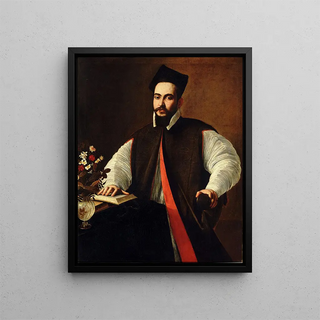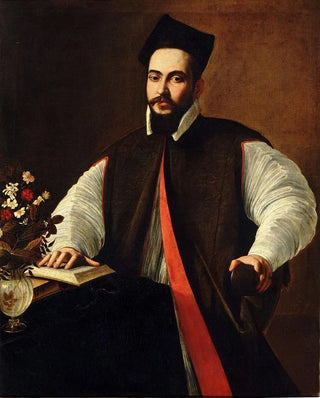Art print | Portrait of Pope Urban VIII - Caravaggio Source: Reproduction | Portrait du pape Urbain VIII - Le Caravage


View from behind

Frame (optional)
Portrait of Pope Urban VIII - Caravaggio – Captivating Introduction
The "Portrait of Pope Urban VIII" by Caravaggio is an iconic work that embodies both the power of the subject and the artist's technical mastery. This canvas, painted in the early 17th century, stands out for its striking realism and dramatic lighting, typical of the baroque style. As you contemplate this piece, you are transported into a universe where light and shadow engage in a fascinating dance, revealing the complex personality of Urban VIII, a pope who marked his era through his engagement in art and culture. The intensity of the pope's eyes, along with the richness of the details in his attire, testify to Caravaggio's ability to capture the very essence of his subjects.
Style and uniqueness of the work
Caravaggio's style is characterized by striking realism and bold use of chiaroscuro. In the "Portrait of Pope Urban VIII," the artist manages to create an intimate, almost theatrical atmosphere, where each element of the composition contributes to enhancing the stature of the pope. Deep shadows envelop the pontiff's face, emphasizing the contemplative expression that seems to emanate from his gaze. The color palette chosen by Caravaggio, dominated by warm, earthy tones, enhances the emotional depth of the piece. This portrait is not merely a simple representation but becomes a true reflection of Urban VIII's personality, combining majesty and humanity. The way the folds of the pope's robe are rendered with such precision also demonstrates the meticulous attention to detail characteristic of Caravaggio's art.
The artist and his influence
Michelangelo Merisi da Caravaggio, known as Caravaggio, is one of the most influential artists in art history. His innovative approach to realism and his play with light revolutionized painting in his time. By diverging from the idealized conventions of the Renaissance, Caravaggio paved the way for a new form of artistic expression that inspired many artists, both contemporary and future. His use of chiaroscuro had a significant impact on the development of baroque art.

Matte finish

View from behind

Frame (optional)
Portrait of Pope Urban VIII - Caravaggio – Captivating Introduction
The "Portrait of Pope Urban VIII" by Caravaggio is an iconic work that embodies both the power of the subject and the artist's technical mastery. This canvas, painted in the early 17th century, stands out for its striking realism and dramatic lighting, typical of the baroque style. As you contemplate this piece, you are transported into a universe where light and shadow engage in a fascinating dance, revealing the complex personality of Urban VIII, a pope who marked his era through his engagement in art and culture. The intensity of the pope's eyes, along with the richness of the details in his attire, testify to Caravaggio's ability to capture the very essence of his subjects.
Style and uniqueness of the work
Caravaggio's style is characterized by striking realism and bold use of chiaroscuro. In the "Portrait of Pope Urban VIII," the artist manages to create an intimate, almost theatrical atmosphere, where each element of the composition contributes to enhancing the stature of the pope. Deep shadows envelop the pontiff's face, emphasizing the contemplative expression that seems to emanate from his gaze. The color palette chosen by Caravaggio, dominated by warm, earthy tones, enhances the emotional depth of the piece. This portrait is not merely a simple representation but becomes a true reflection of Urban VIII's personality, combining majesty and humanity. The way the folds of the pope's robe are rendered with such precision also demonstrates the meticulous attention to detail characteristic of Caravaggio's art.
The artist and his influence
Michelangelo Merisi da Caravaggio, known as Caravaggio, is one of the most influential artists in art history. His innovative approach to realism and his play with light revolutionized painting in his time. By diverging from the idealized conventions of the Renaissance, Caravaggio paved the way for a new form of artistic expression that inspired many artists, both contemporary and future. His use of chiaroscuro had a significant impact on the development of baroque art.






